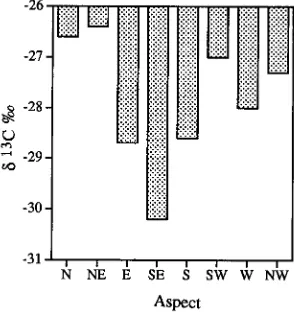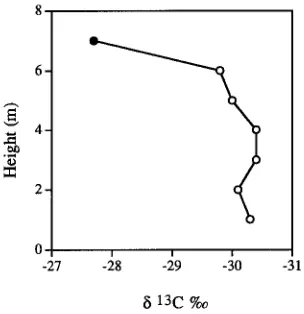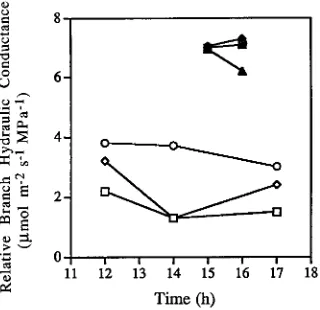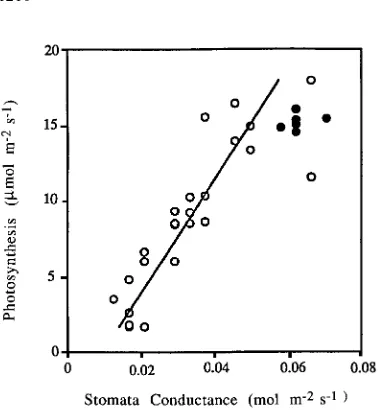Variation in foliar
δδ
13C values within the crowns of Pinus radiata
trees
RICHARD H. WARING1 and WARWICK B. SILVESTER2 1 College of Forestry, Oregon State University, Corvallis, Oregon 97331, USA
2 Department of Biological Sciences, The University of Waikato, Private Bag 3105, Hamilton, New
Zealand
Received February 16, 1994
Summary
Although herbaceous species generally show little within plant variation in δ13C, trees show large spatial and temporal differences. We found that the aspect of exposure and branch length accounted for up to 6‰ δ13C difference within the foliage of individual trees of Pinus radiata D. Don. The foliage on branches 0.5 m in length was as much as 4‰ more depleted in 13C than foliage on 10-m long branches, and an additional 2‰ more depleted on the shaded side than on the exposed side. We confirmed that on clear days, relative branch hydraulic conductivity, defined as the ratio of transpiration to the water potential gradient, was much higher in short branches than in long branches. Stomatal conductance remained high in foliage on short branches during the day, whereas it declined progressively in long-branch foliage under similar conditions. These differences were sufficient to explain the observed variation in δ13C in foliage on long and short branches.
Keywords: carbon isotopes, hydraulic conductance, isotope fractionation, stomatal conductance, water potential.
Introduction
The heavy stable isotope of 13C is discriminated against during photosynthetic uptake of CO2. This depletion of 13C, as measured in the products of photosynthesis, is
moderated by the rate at which CO2 diffuses into the leaf and the rate at which CO2
is fixed by RuBP carboxylase (Farquhar et al. 1982a). The average value of 13C depletion for C3 plants is approximately −27‰, and the wide range of values about
this mean reflects the various degrees of stomatal control and water-use efficiency of plants. The accepted model for this process (Farquhar et al. 1988) predicts that any environmental stress limiting CO2 diffusion into leaves will lower the internal partial
pressure of CO2 below normal, and result in photosynthetic products that are less
depleted in 13C. Variation in δ13C among crop cultivars and other herbaceous species has been studied intensively, and differences in isotope ratio have been correlated with differences in water use efficiency (Farquhar et al. 1982b, Farquhar and Richards 1984).
both within individual plants and among species. Variations in δ13C of as much as 5‰ have been reported for cellulose extracted from annual rings (Craig 1954, Grinsted and Wilson 1979), within branches (Francey et al. 1985), and between neighboring trees of similar age (Leavitt and Long 1986), as well as among trees of different ages (Yoder et al. 1994). Irradiance is an important factor modifying δ13C in the foliage of huron pine in Australia (Francey et al. 1985), and there is little doubt that the same processes that control δ13C in herbaceous plants also operate in trees. Two major conclusions can be drawn from the existing literature concerning trees. First, cellulose in the growth rings of trees becomes less depleted in 13C as trees age (Jansen 1962, Francey and Farquhar 1982, Grootes et al. 1989). Second, there can be as much variation in 13C ratios of pure cellulose extracted from current foliage, twigs and wood as is observed between young and old trees (Leavitt and Long 1986).
Experimental designs to cope with the large variation in δ13C within trees have centered on pooling numbers of samples to provide values that express the weighted mean of the whole tree (Leavitt and Long 1984). Despite the apparent variation in values and difficulties in interpreting contemporary 13C ratios in trees, considerable weight is put on temporal changes in 13C abundance in tree rings as indicators of past climate change (Mazany et al. 1980, Becker et al. 1991). We have attempted to define the physiological factors operating within a tree that could give rise to the observed and unexplained variation in 13C abundance.
Trees, because of their size and longevity, offer the opportunity for talization of processes and products in space and time. One result of compartmen-talization is that the main stem of a tree offers less resistance to water movement than the branches (Richter 1973, Tyree 1988). Internal resistance to water flow should increase substantially as branches lengthen (Pothier et al. 1989). When transpiration approaches maximum rates on any branch, partial stomatal closure occurs, thus preventing irreversible cavitation in that branch (Tyree and Sperry 1988). Atmos-pheric water vapor deficits and light exposure are the two principal modifiers of stomatal aperture and, indirectly, 13C ratios. We hypothesized, therefore, that for any given species, the length and exposure of a branch should account for the majority of 13C variation reported in foliage and, by inference, annual growth rings.
Methods
Site description
The experiments consisted of two major parts. First, we determined variation in
13
C according to branch length and position on open-grown trees, and second, we made physiological measurements to assess stomatal conductance, photosynthesis and water tension on various sizes of branches exposed to comparable illumination throughout the day.
Isotope measurements
Duplicate carbon isotope measurements were made on three to four 1-mm segments taken from the center portion of needles collected from the current, but mature, fully exposed fascicles situated near the ends of branches. The needle segments were dried, sealed in aluminum foil, and analyzed for δ13C with a continuous flow combustion analyzer connected to a GC--MS (Europa Tracemass). All analyses were run against the CSIRO sucrose standard and recalculated in relation to the Pee Dee Belemnite standard, with variation in the analysis of less than 0.2‰. Similar variation was observed between duplicate samples of foliage.
To document possible variation in 13C associated with aspect, we selected a 20-yeold, open-grown pine tree with 8--10-m long branches symmetrically ar-ranged and with foliage accessible from the ground. We collected duplicate samples of foliage from the ends of eight branches representing different directions of exposure around the tree.
To document possible variation in 13C associated with branch length, we collected foliage from the lower branches of more than a dozen 12- to 20-year-old trees. Most trees were open grown so that separate samples from the predominantly sunny northwestern exposure and the less exposed southeastern aspect could be compared. In a few cases, collections were restricted to only one exposure because of shade cast by adjacent trees. Branches ranged in length from 0.5 to 10 m.
To assess the possible influence of tree height on 13C ratios, we collected exposed foliage from one tree growing as part of a hedge with branches pruned to 0.3 m in length up to a height of 6 m. We collected foliage samples at 1-m intervals from the base upward and included one sample from a 2.5-m long branch at a height of 7 m.
Photosynthesis and stomatal conductance measurements
Determination of branch hydraulic conductance
In the laboratory, saturated hydraulic conductivity of detached branches was meas-ured under steady state conditions of 300 µmol m−2 s−1 PAR at 25 °C with a vapor pressure deficit of 1.5 kPa and unlimited water supply. A constant transpiration rate could be maintained for over 2 h with either tap water or distilled water. We first removed all bark from the lower 10 cm of the cut branch, then cut a clean surface and plunged the end of the branch into boiling water for at least 60 s. The boiling water killed resin-producing parenchyma cells, which was essential to keep the cut surface clean. Organic solvents were not appropriate as they would injure the foliage when transported through the vascular system. The boiling process also released most trapped gases and, as a result, increased the conducting properties to near maximum (< 5% increase in flux observed when boiling was extended to 5 min). A beaker was placed under the submerged branch end, and the branch was fastened into a ring stand positioned above a weighing balance. The weighing balance was programmed to record the loss of water from the beaker in ml min−1 at 1-min intervals. A specially designed pressure chamber was used to measure xylem water potentials on individual needle fascicles with a precision of 0.2 MPa. Branch hydraulic conductance was calculated as the ratio of flux (mmol m−2 s−1) to the water potential gradient (MPa). In the field, the water potential difference between predawn and daytime readings defined the gradient.
Results
Branch aspect had a significant influence on δ13C values. The general pattern observed on three separate trees matched that illustrated in Figure 1, showing δ13C values above −27‰ on the most exposed northerly aspects and values below −30‰ on the least exposed SE aspect from a tree with 8--10-m long branches.
Sampling of needles from trees with 0.5 to 10-m long branches representing extremes in exposure showed 13C enrichment varied consistently and linearly with branch length (Figure 2). Ten-meter long branches showed up to 4‰ enrichment in
13
C compared to 0.5-m long branches regardless of the aspect of exposure.
Branch length, rather than branch height, appeared to be the major contributor to variation in δ13C as demonstrated by the finding that foliage sampled at the ends of 0.3-m long pruned branches collected from heights of 1 to 6 m from a hedged pine had values of −29.8‰ to −30.5‰, respectively (Figure 3). Significant changes in 13C enrichment occurred only above the pruned level at 7 m where branches reached a length of 2.5 m. Based on these comparisons of 13C variation in foliage collected from the ends of branches of various lengths, aspects and heights, we inferred that the shorter a branch and the less its exposure to solar radiation, the more favorable should be its water relations. Physiological measurements made in the morning and afternoon of a clear day confirmed that water relations were more favorable for foliage on short shaded branches than on long exposed branches (Figure 4).
Branch hydraulic conductance, estimated on fascicles of needles at the ends of 7-m long branches, showed a progressive decrease in mean values throughout the day, from the most exposed aspect (NW), through the W, to the least exposed aspect (SW). At 1400 h, up to a 50% drop in hydraulic conductivity was recorded on the intermediate (W) exposed branch that was unrelated to any significant change in
water potential between branch exposures (−1.43 to −1.46 MPa). At 1400 h, the fully exposed long branches (W and NW) had photosynthetic rates of 2 µmol m−2 s−1 and transpiration rates of 1.5 mmol m−2 s−1, whereas the less exposed branch (SW) had values of 14 µmol m−2 s−1 and 3.8 mmol m−2 s−1, respectively. Near the same time, three samples from 0.25-m long branches on a NW-facing hedge had three times the hydraulic conductance of the fully exposed long branches (Figure 4). At 1500 to 1600 h, the three short branches exhibited photosynthetic rates of 15.1 ± 0.2 µmol m−2 s−1 and stomatal conductances of 0.062 ± 0.1 mmol m−2 s−1 with water potentials
Figure 2. Values of δ13C for foliage of Pinus radiata from branches of different length and aspect. Foliage was taken from low branches on predominantly sunny NW (s) aspects and shaded SE (d) aspects. Long branches were sampled from several 12--20-year-old open-grown trees, whereas short branches were from hedged trees 12--14 years old.
Figure 3. Values of δ13C for foliage of a trimmed Pinus radiata hedge at different heights and branch lengths. An exposed (NW facing) hedge was sampled at 1-m intervals from the base up to 6 m where trimming had ceased (s). Foliage from one 2.5-m long branch was analyzed above the pruned level at a
averaging −1.13 ± 0.02 MPa.
In narrow-leafed conifers such as P. radiata, the leaf and air temperatures are generally within a few degrees of each other (Riha and Campbell 1985). Because the water potential gradient did not vary significantly from the sunny to the shaded side of a tree (see data above), we assumed that differences in flux of water through branches must be related, under favorable conditions, to the amount of light available for photosynthesis. Gas exchange measurements showed a general increase in sto-matal conductance with increases in photosynthetic rate that could explain how transpiration might initially be increased on the sunny side of trees compared to the shaded side. With continued exposure to high solar irradiance, however, hydraulic conductance decreased so that, overall, photosynthesis was closely coupled to changes in stomatal conductance (Figure 5).
Discussion
The physiological data acquired from the one-day field experiment together with subsequent measurements provide evidence that differences in branch hydraulic conductance play a major role in explaining the observed variation in δ13C values in foliage on branches of varying lengths and exposure. If the main stem or root system were contributing significantly to an increase in resistance to the movement of water through the vascular system, we would have expected less variation in hydraulic conductance with aspect and branch length, and more variation with height. Tyree (1988) provides additional evidence that the branch system offers the major resis-tance to water flow through trees. Rapid diurnal changes in the hydraulic conduc-tance of mature trees have been reported in similar situations where clear days
followed a long period of cloudy wet weather (Waring and Running 1978, Whitehead et al. 1984). Partial recovery of embolized tracheids can occur overnight (Sobrando et al. 1992), although a longer period of cloudy wet weather is normally required (Chalk and Bigg 1956, Waring and Running 1978). On the North Island of New Zealand, temperatures are mild and precipitation is well distributed throughout the year. In such an environment, cavitation in xylem elements in sapwood should be minimal, resulting in branch length being the major contributor to variation in hydraulic conductance. Still, on long branches at the end of the day we found sapwood water contents at about 90% of saturation. If, in the morning, sapwood were saturated, the presumed change in water content would result in about a 25% reduction in hydraulic conductivity in accordance with studies done on spruce branches (Sellin 1991). In more extreme environments, where cavitation occurs more frequently, only a small fraction of sapwood remains functional throughout the year. This may contribute to a reduction in hydraulic conductance equal to or greater than that associated with branch length (Jeanne Panek, Oregon State University, personal communication).
On a clear day, stomata open progressively as the opportunity for photosynthesis increases (cf. Meinzer 1982, Wong et al. 1985, Teskey et al. 1986). On a day with prolonged high irradiance and high humidity deficits, however, we observed signifi-cant decreases in the hydraulic conductance of long branches exposed to direct radiation for more than 3 h. These decreases were associated mainly with a reduction in stomatal conductance rather than with a change in water potential gradient
(Figure 4). In contrast, on short branches stomata remained open throughout the day (see stomatal conductance data and Figure 5) and photosynthetic rates remained high. Differences in stomatal behavior associated with branch length and aspect of exposure provide a mechanism to explain the 13C variation. In long branches stomatal closure induced by changes in the water conducting properties of wood should, if carboxylation capability does not change, reduce internal CO2 (Ci) resulting in less
depletion of 13C in the leaves, whereas in short branches, stomata remain open and Ci is relatively high, resulting in more 13C-depleted photosynthetic products.
The use of total leaf carbon in analyzing 13C and relating this to photosynthesis has some obvious advantages and some less obvious interpretational difficulties. With samples from whole leaves, the time required for processing is minimal and analysis may be made with an automated continuous flow mass spectrometer within 10 min of taking a leaf sample. Current photosynthesis, however, may not be well repre-sented because carbon laid down in the leaf tissue may be the result of photosynthetic activities during leaf emergence, or possibly the result of mobilized reserves assimi-lated under varying environmental conditions, or both. We rationalized that our measurements on whole leaves were a good representation of general environmental responses because P. radiata photosynthesizes all year on the North Island of New Zealand. In such a case, we believe that carbon in needles most likely originates from photosynthesis in the shoot. Even in more extreme environments, most of the carbon in new foliage of coniferous species is the product of the foliated shoot itself, not imported (Webb and Kilpatrick 1993).
The 13C values in leaves integrate photosynthetic conditions over the period of leaf development and, to the extent that the products of photosynthesis remain in the leaf, the condition currently prevailing. The effects of exposure on 13C values have been previously reported (Farquhar et al. 1988 ) but the eccentric distribution of 13C about a tree (Figure 1) have not. Our understanding of these relationships is enhanced by the physiological interpretation shown in Figure 4 that demonstrates a difference in SW- and W-facing long branches that could easily explain the 13C differences observed in Figure 1.
The effects of branch length on hydraulic conductance (Figure 4) and δ13C (Figures 2 and 3) appear significant and provide a likely explanation for the so-called ‘‘age’’ effect in 13C ratios in wood. This age phenomenon, reported for whole wood and cellulose by Grinsted and Wilson (1979), shows that young wood is significantly more 13C depleted than older wood. The 13C values tend to flatten out and become consistent after 50 to 200 years, and have been attributed to uptake of respired CO2
height growth ceases, canopy branches elongate and most foliage is situated at the distal end of the branches. Thus, one would expect the wood of mature trees to reflect the higher resistance to water movement along these long branches and be signifi-cantly less depleted in 13C than the wood of immature trees.
Acknowledgments
This work was made possible by a research grant from the University of Waikato Research Committee and by salary support from National Aeronautics and Space administration for Dr. Waring during his 6-week stay in New Zealand. We appreciate the dedicated assistance of Paul Stock and Doris Waring in this project and thank Vivienne Robson for typing the manuscript and Frank Bailey for preparing the figures. We are also grateful to Jeanne Panek who provided helpful comments on earlier drafts of the manuscript.
References
Becker, B., B. Kromer and P. Trimborn. 1991. A stable-isotope tree-ring time scale of the Late Glacial/Holocene boundary. Nature 353:647--649.
Chalk, L. and J.M. Bigg. 1956. The distribution of moisture in the living stem in Sitka spruce and Douglas-fir. Forestry 29:5--21.
Craig, H. 1954. Carbon-13 variations in Sequoia rings and the atmosphere. Science 119:141--143. Farquhar, G.D. and R.A. Richards. 1984. Isotopic composition of plant carbon correlates with water-use
efficiency of wheat genotypes. Aust. J. Plant Physiol. 11:439--552.
Farquhar, G.D, M.H. O’Leary and J.A. Berry. 1982a. On the relationship between carbon isotope discrimination and intercellular carbon dioxide concentration in leaves. Aust. J. Plant Physiol. 9:121--137.
Farquhar, G.D, M.C. Ball, S. Von Caemmerer and Z. Roksandic. 1982b. Effect of salinity and humidity on δ13C value of halophytes----evidence for diffusional isotope fractionation determined by the ratio of intercellular/atmospheric partial pressure of CO2 under different environmental conditions. Oecologia
52:121--124.
Farquhar, G.D., K.T. Hubich, A.G. Condon and R.A. Richards. 1988. Carbon isotope fractionation and plant water-use efficiency. In Stable Isotopes in Ecological Research. Eds. P.W. Rundel, J.R. Ehlerin-ger and K.A. Nogy. SprinEhlerin-ger-Verlag, New York, pp 21--40.
Francey, R.J. and G.D. Farquhar. 1982. An explanation of 13C/12C variation in tree rings. Nature 297:28--31.
Francey, R.J., R.M. Gifford, T.D. Sharkey and B. Weir. 1985. Physiological influences on carbon isotope discrimination in huron pine (Lagastrobos franklinii). Oecologia 66:211--218.
Grinsted, M.J. and A.T. Wilson. 1979. Variations of 13C/12C ratio in cellulose of Agathis australis (kauri) and climatic change in New Zealand during the last millenium. N.Z. J. Sci. 22:55--61.
Grootes, P.M., G.M. Farwell, F.H. Schmidt, D.D. Leach and M. Stuiver. 1989. Rapid response of tree cellulose radiocarbon content to changes in atmospheric 14CO2 concentration. Tellus 41B:134--148.
Jansen, H.S. 1962. Depletion of carbon-13 in a young kauri tree. Nature 196:84--85.
Johnson, R.C. and L.L. Tieszen. 1993. Carbon isotope discrimination, water relations, and gas exchange in temperate grass species and accessions. In Stable Isotopes and Plant Carbon--Water Relations. Eds. J.R. Ehleringer, A.E. Hall and G.D. Farquhar. Academic Press, San Diego, CA, pp 281--296. Leavitt, S.W. and A. Long. 1984. Sampling strategy for stable carbon isotope analysis of tree rings in
pine. Nature 311:145--147.
Leavitt, S.W. and A. Long. 1986. Stable-carbon isotope variability in tree foliage and wood. Ecology 67:1002--1010.
Mazany, T., J.C. Lerman and A. Long. 1980. Carbon-13 in tree ring cellulose as an indicator of past climates. Nature 287:432--435.
Meinzer, F.C. 1982. The effect of light on stomatal control of gas exchange in Douglas-fir (Pseudotsuga
Pothier, D., H.A. Margolis and R.H. Waring. 1989. Patterns of change of saturated sapwood permeability and sapwood conductance with stand development. Can. J. For. Res. 19:4327439.
Richter, H. 1973. Frictional potential losses and total water potential in plants: a re-evaluation. J. Exp. Bot. 31:983--994.
Riha, S.J. and G.S. Cambell. 1985. Estimating water fluxes in Douglas-fir plantations. Can. J. For. Res. 15:701--707.
Sellin, A. 1991. Hydraulic conductivity of xylem depending on water saturation level in Norway spruce (Picea abies (L.) Karst.). J. Plant Physiol. 138:466--469.
Sobrado, M.A., J. Grace and P.G. Jarvis. 1992. The limits to xylem embolism recovery in Pinus
sylvestris L. J. Exp. Bot. 43: 831--836.
Teskey, R.O., J.A. Fites, L.J. Samuelson and B.C. Bongarten. 1986. Stomatal and nonstomatal limitations to net photosynthesis in Pinus taeda L. under different environmental conditions. Tree Physiol. 2:131--142.
Tyree, M.T. 1988. A dynamic model for water flow in a single tree: evidence that models must account for hydraulic architecture. Tree Physiol. 4:195--217
Tyree, M.T. and J.S. Sperry. 1988. Do woody plants operate near the point of catastrophic xylem dysfunction caused by dynamic water stress? Plant Physiol. 88:574--580.
Walcroft, A. 1994. Aspects of δ13C variation in woody plants. M.S. Thesis, University of Waikato, Hamilton, New Zealand.
Waring, R.H. and S.W. Running. 1978. Sapwood water storage: its contribution to transpiration and effect upon water conductance through the stems of old-growth Douglas-fir. Plant Cell Environ. 1:131--140. Webb, W.L. and K.J. Kilpatrick. 1993. Starch content in Douglas-fir: diurnal and seasonal dynamics. For.
Sci. 39: 359--367.
Whitehead, D., P.G. Jarvis and R.H. Waring. 1984. Stomatal conductance, transpiration, and resistance to water uptake in a Pinus sylvestris spacing experiment. Can. J. For. Res. 14:692--700.
Wong, S.W., I.R. Cowan and G.D. Farquhar. 1985. Leaf conductance in relation to rate of CO2
assimilation. II. Effects of short-term exposures to different photon flux densities. Plant Physiol. 78:826--829.



